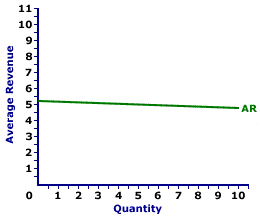
|
|
FIXED FACTOR OF PRODUCTION: An input whose quantity cannot be changed in the time period under consideration. This usually goes by the shorter term fixed input and should be immediately compared and contrasted with variable factor of production, which goes by the shorter term variable input. The most common example of a fixed factor of production is capital. A fixed factor of production provides the "capacity" constraint for the short-run production of a firm. As larger quantities of a variable factor of production, like labor, are added to a fixed factor of production like capital, the variable input becomes less productive. This is, by the way, the law of diminishing marginal returns. For more detailed discussion, take a look at the shorter, more commonly used alias of fixed factor of production, which is fixed input.
Visit the GLOSS*arama
|
|


|

|
                           AVERAGE REVENUE CURVE, MONOPOLISTIC COMPETITION: A curve that graphically represents the relation between average revenue received by a monopolistically competitive firm for selling its output and the quantity of output sold. Because average revenue is essentially the price of a good, the average revenue curve is also the demand curve for a monopolistically competitive firm's output. Monopolistic competition is a market structure with a large number of relatively small firms that sell similar but not identical products. Each firm is small relative to the overall size of the market such that it has some market control, but not much. In other words, it can sell a wide range of output at a narrow range of prices. This translates into a relatively elastic demand curve. If a monopolistically competitive firm wants to sell a larger quantity, then it must lower the price.The average revenue curve reflects the degree of market control held by a firm. For a perfectly competitive firm with no market control, the average revenue curve is a horizontal line. For firms with market control, such as monopolistic competition, the average revenue curve is negatively-sloped. Average Revenue Curve,
Sandwich Style |  |
The average revenue curve for Manny Mustard is displayed in the exhibit to the right. Key to this curve is that Manny Mustard is a monopolistically competitive seller of sandwiches and thus faces a negatively-sloped demand curve. Larger quantities of output are only possible with lower prices.The vertical axis measures average revenue and the horizontal axis measures the quantity of output (number of sandwiches). Although quantity on this particular graph stops at 10 sandwiches, it could go higher. This curve indicates that if Manny Mustard sells 1 sandwich (at $5.20 per sandwich), then average revenue is $5.20 per sandwich. Alternatively, if he sells 10 sandwiches (at $4.75 per sandwich), then average revenue in is $4.75 per sandwich. For Manny Mustard the average revenue curve is also the demand curve. The curve is negatively sloped, meaning that larger quantities of output result in less average revenue. Although this average revenue curve, and preceding table of average revenue numbers, is based on the production activity of Manny Mustard, a well-known monopolistically competitive firm, they apply to any firm with market control. Monopoly and oligopoly firms that also face negatively-sloped demand curves generate comparable average revenues.

Recommended Citation:AVERAGE REVENUE CURVE, MONOPOLISTIC COMPETITION, AmosWEB Encyclonomic WEB*pedia, http://www.AmosWEB.com, AmosWEB LLC, 2000-2025. [Accessed: July 18, 2025].
Check Out These Related Terms... | | | | | | | | |
Or For A Little Background... | | | | | | | | | | | |
And For Further Study... | | | | | | | | |
Related Websites (Will Open in New Window)... | | | |
Search Again?
Back to the WEB*pedia
|



|

|
PURPLE SMARPHIN
[What's This?]
Today, you are likely to spend a great deal of time flipping through mail order catalogs trying to buy either a flower arrangement for your aunt or a birthday greeting card for your uncle. Be on the lookout for rusty deck screws.
Your Complete Scope
This isn't me! What am I?
|

|
|
In 1914, Ford paid workers who were age 22 or older $5 per day -- double the average wage offered by other car factories.
|

|
|
"A winner is someone who recognizes his God-given talents, works his tail off to develop them into skills, and uses those skills to accomplish his goals. " -- Larry Bird, basketball player
|

|
FDA
Food and Drug Administration
|

|
|
Tell us what you think about AmosWEB. Like what you see? Have suggestions for improvements? Let us know. Click the User Feedback link.
User Feedback
|


|


